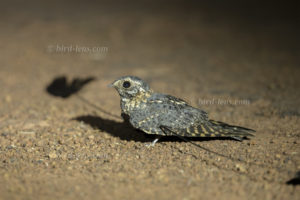 As dusk falls, the purring cries of the African Scops Owl (Otus senegalensis) sound softly from the savannah. Darkness breaks in. We want to end the day with one of the most incredible birds of the savannah. A male Standard-winged Nightjar (Caprimulgus longipennis) in full display dress is supposed to make his courtship flights over its territory on a terrain with barren stones in the middle of the densely vegetated savannah. Males and females of this species gather at these display arenas (the so-called leks) immediately after dusk in open places in the savannah. The males meet on the ground as well as in the air. They sometimes run towards each other in abrupt movements, but also move in a circle 1-8 m above the ground and sometimes swooping low over another bird on the ground. In contrast male displays to female are given by flying around the female giving faint clicking calls. As a result, the female Standard-winged Nightjar land nearby or fly with trembling wingbeats around the males while calling as well.
As dusk falls, the purring cries of the African Scops Owl (Otus senegalensis) sound softly from the savannah. Darkness breaks in. We want to end the day with one of the most incredible birds of the savannah. A male Standard-winged Nightjar (Caprimulgus longipennis) in full display dress is supposed to make his courtship flights over its territory on a terrain with barren stones in the middle of the densely vegetated savannah. Males and females of this species gather at these display arenas (the so-called leks) immediately after dusk in open places in the savannah. The males meet on the ground as well as in the air. They sometimes run towards each other in abrupt movements, but also move in a circle 1-8 m above the ground and sometimes swooping low over another bird on the ground. In contrast male displays to female are given by flying around the female giving faint clicking calls. As a result, the female Standard-winged Nightjar land nearby or fly with trembling wingbeats around the males while calling as well.
The Standard-winged Nightjar is named – of course – after their standards. Here you should be aware that “standard” means something like a flag. The male Standard-winged Nightjar has extremely elongated, second innermost primarie feathers, which are webbed at tips only, forming “standards” or flags. – They are what prompted the species name: longipennis (long feather). However, what has been said before also means that these flags are not tail feathers of the male. But the Standard-winged Nightjar is certainly one of the most impressive members of the Caprimulgid family. It should be noted that male Flag Daggers can control their striking and spectacular “flags” with their muscles at the wings.
This true nightjar species breeds in dry savannah habitat of central Africa. During the breeding season, the male grows highly-specialized wing feathers up to 38 cm long, primarily of bare shaft with feather plumes on the end. The feathers are used as part of a flight display to attract female.
We sat down on the warm boulders in the savannah. Quickly with the darkness also the harassment by the small bees disappeard. Then the first male Standard-winged Nightjar flew in. Again and again the male flew up. At first it did not want to be too close admired by the impressed human visitors. Sometimes in flight it looked as if the bird would be followed by two more birds or even bats. At the end of our stay we could hear the purring of the male. We stayed a bit at the spot sitting on the barren rocks. Sitting on the warm boulders was amazingly enjoyable. The longer we stayed, the more we noticed that there seemed to be differences in flight behavior. In the beginning, the male flew very low, with the “flags” upright, like flags. I was sure that this is his display flight. Later, we saw a flight with the flags shaking behind him. This is more likely to have been a feeding flight.
After a while, it was impressive to realize, that the bird seemed to have become accustomed to us and the light of our flashlights. The bird remained sitting on the ground, occasionally making striking leaps in the air. The flags or standards were thrown in the air like counterweights. Then they landed again on the floor with some time difference.
It is obvious that these long feathers are supposed to impress females. It is also pretty sure that this is an example of sexual selection – only the male has the feathers and it only has them during the mating season.
- What exactly does the female see?
- Is it simply the length and shape of the feathers she likes, or is there something about the way he does the display that somehow reveals his fitness?
- What exactly is it about the display? Is it supposed to look like two birds following him or is that just an aerodynamic consequence of having those long streamers?
The surrounding Guinea savanna woodlands in Mole NP were generally rich in birdlife and other species
The many goodies we saw included Beautiful Sunbird (Cinnyris pulchellus), Lavender Waxbills (Estrilda coerulescens), Common Gonolek or Yellow-crowned Gonolek (Laniarius barbarus), Senegal Batis (Batis senegalensis), Grey-throated Bunting (Emberiza goslingi), Familiar Chat (Oenanthe familiaris) and Stone Partridges (Ptilopachus petrosus).
To cope with the growing demand for top shots of the rarer species of the Palearctic Bird-Lens is keen to enrich the range of pictures of birds not only in the western Palearctic. Trips to remote places like this one to capture images were very successful. The nice image of the blog is only a first impression, what you will find in the gallery in the “Picture Shop” very soon. Just give bird-lens.com a message, if www.bird-lens.com could serve you with an image needed before the new pictures are online.